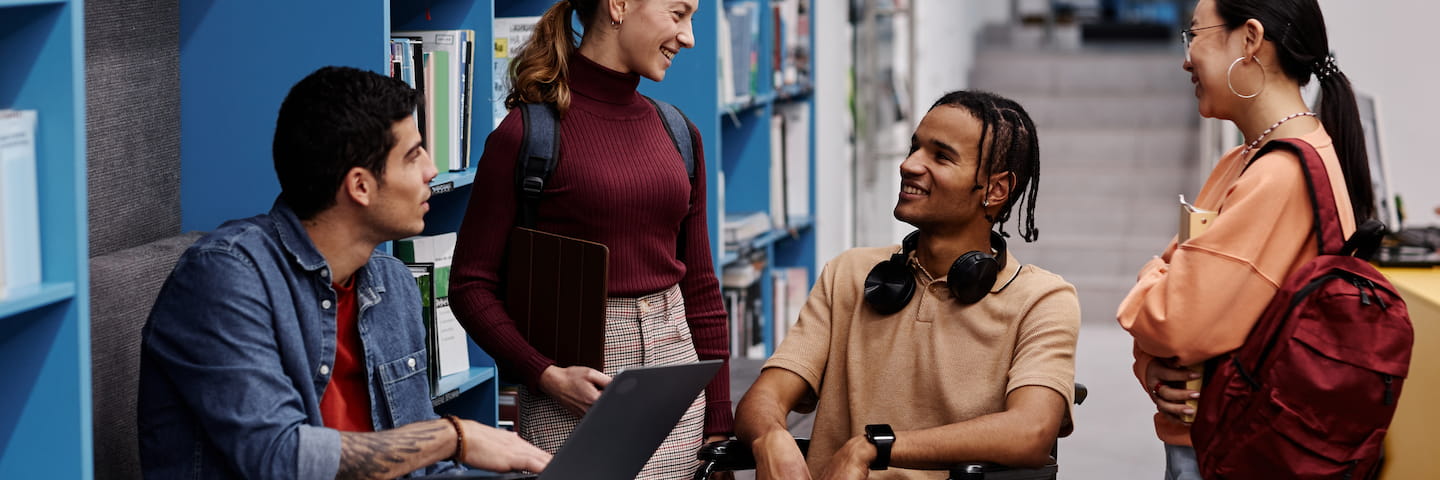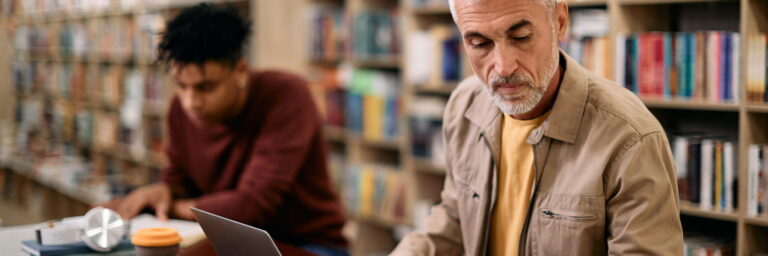Self-advocacy is one of the important steps students with disabilities need to take as they enter college. But it can be challenging, namely because it’s hard to know where to find the resources you need. When Arizona State University student Savannah Treviño-Casias encountered a professor who refused to accommodate her learning disability, she immediately sought help.
“I reached out to the community college’s disability services office,” she told the National Center for Learning Disabilities. “I also talked to the dean of students. I looked for and found the people at the school who were empowered and prepared to step in when issues like this arise.”
While self-advocacy is necessary, it can also be incredibly intimidating. That’s why we’ve created this guide, which provides abundant information about attending college when you have a disability. You’ll find details about disability types, common accommodations, and lists of resources. If you’re a student with a disability — or you know someone who is — keep reading to discover helpful tips.
College with a Disability: The Basics
While there are a number of laws in place to protect your rights as a college student, sometimes the reality can be challenging. Approximately 20% of college students report having a disability, yet only about 8% register with their school’s disability services office. This may be due to several factors, including stigma and lack of information or support.
Depending on your situation, this may be the first time you’re navigating things on your own, requesting accommodations, and managing your schedule. We’re here to help you understand your rights, find support, and ultimately access the accommodations you need.
Know Your Rights
Many laws protect the rights of students with disabilities, including the American Disabilities Act (ADA), which became federal law in 1990. The ADA protects the civil rights of individuals with disabilities, prevents discrimination, and ensures accommodations when it comes to employment, education, government, private businesses, transportation, and more. There are some limitations to the law, but essentially it ensures that colleges (both private and public) make reasonable accommodations for students with disabilities. This could range from requiring wheelchair ramps leading into buildings to providing sign language interpreters in lectures.
In addition to the broad protections offered by the ADA, the Rehabilitation Act of 1973 prevents discrimination against individuals with disabilities in federal employment or in programs receiving federal monies. Section 504 of the act has led to increased disability support services at colleges and universities. Nearly all higher education institutions receive federal support, so they fall under the jurisdiction of this legislation.
Most colleges and universities have a disability services office, which is a good starting point when you need to request help. You will often need to provide a letter documenting your disability when you request assistance. If you encounter resistance or refusal, you can file a complaint with the Department of Justice, Civil Rights Division.
Disclosing & Discussing Your Disability
While you have every right to choose with whom you discuss your disability, there are some occasions when you’ll need to disclose specifics. The following situations may require more thorough documentation or discussion:
- Requesting accommodations. A letter documenting your disability will likely need to be supplied (to a disability office and/or professor) in order to ensure you receive learning accommodations.
- Accessing benefits/privileges. Depending on your school, you may need to submit a documented request every time you need an accommodation (extra time on an exam, a different type of exam, a course load modification, etc.).
- Navigating unusual circumstances. Some accommodations and disabilities might be a bit more nuanced, which is why working with a disability services representative and discussing options may be in order.
Transitioning to College
The most important step in getting the assistance you need is requesting accommodations from the appropriate representative at your school. Be prepared to show documentation that records your disability. Most colleges and universities have a disability services office, but if they don’t, you may need to meet with student services or a dean.
Once you’ve made the initial contact and/or filed an application, you’ll be issued an accommodation letter to then show to individual professors and instructors. Depending on your college, you may need to request an accommodation letter every semester or school year.
Once you have your letter in hand, it’s your job to meet with your individual professors to set up accommodations. For accommodations specific to exams (extra time, a different type of test), you may need to submit a request before each exam. Have open conversations with your professors to determine best practices.
Resources by Disability Type
Nearly one-fifth of undergraduates report having a disability, and those numbers are even higher in groups such as veterans and older (age 30+) students. So it’s important to keep in mind that you are not alone. Visible or not, disabilities are common, and institutions are continuing to adapt their offerings to make them more accessible.
Whether you’re currently managing a disability or want to support a friend, there are resources that can help. Below, we’ve highlighted seven of the most common disabilities, as well as the accommodations that students with this disability might need. We’ve also scoured the internet for resources that can help make college life a little easier, whether it’s a useful app or a link to an online support group — among other practical offerings.
-
Learning Disabilities
There are many types of learning disabilities that can affect the way you understand written or spoken language, the way you organize thoughts and concepts, or your ability to understand and work through mathematical concepts. For example, dyslexia is a common learning disability that involves difficulty learning to read. Dyslexic students often have trouble decoding words in written text.
If you’re a student with a learning disability, you may benefit from a variety of accommodations depending on the situation. Examples might include having a dedicated note-taker for classes, the ability to record lectures, or the use of a calculator in exams. This list isn’t exhaustive, and there are many types of accommodations available depending on the individual.
Resources
- ADDitude Magazine is a publication that covers all things pertaining to attention deficit disorder (ADD) and ADHD. It offers relevant articles, symptom checkers, information about treatment, and more.
- Bookshare offers textbooks in a variety of accessible formats such as through an assistive technology device or smart reader.
- DO-IT (Disabilities, Opportunities, Internetworking, and Technology) is a collaboration between the National Science Foundation, Department of Education, and State of Washington that aims to increase participation of students with disabilities in STEM programs (science, technology, engineering, and mathematics).
- Invisible Disabilities in Post-Secondary Education is a video detailing effective accommodations for college students with learning (and other) disabilities.
- LD Online is a comprehensive resource that isn’t necessarily geared towards college students, but it provides useful and easy-to-understand information about learning disabilities and attention deficit hyperactivity disorder (ADHD).
- Learning Disabilities Association of America is a grassroots non-profit that empowers and supports the rights of individuals with learning disabilities.
- The Campus Disability Resource Database offers a searchable database of disability-related information for most degree-granting institutions in the United States.
- The National Center for Learning Disabilities conducts research, promotes awareness, and offers scholarships for students of all ages.
- The OTs with Apps blog lists several apps that are helpful for students of all ages with learning disabilities (think: concept mapping apps, voice dictionaries, note takers, and more).
- The Yale Center for Dyslexia and Creativity offers resources and awareness surrounding dyslexia.
-
Physical Disabilities
Physical disabilities can prove to be a challenge for college students and can range from mild to severe impairments in mobility. Depending on your specific situation, you may need assistance walking, writing, or manipulating other learning instruments. Physical disabilities may be short term (e.g., a broken leg) or longer lasting (e.g., cerebral palsy).
Common accommodations for students with physical disabilities might include allowing use of your own equipment (desk chairs, writing surface), ensuring any offsite visits/field trips/labs have adequate accessibility, or extra time for assignments.
Resources
- Accessibility by Design from Colorado State University has information about electronic accessibility: best practices, training, and more.
- American Disabilities Association (ADA) is a thorough resource regarding mobility devices and the laws surrounding them.
- American Association on Health & Disability focuses on research and policy and offers scholarships for qualified students.
- Association for Higher Education and Disability offers a wealth of information including research, webinars, and assessment services.
- This resource guide from Indiana University of Pennsylvania compiles information for teaching college students with physical and mobility issues.
- Need help with negotiating your accommodations? This Mobility International USA site has tips and advice.
- This MIUSA guide offers tips on preparing for travel and study abroad for students with physical disabilities.
- The National Educational Association of Disabled Students is a Canadian-based organization that provides information such as a resource locator, workshops, and a newsletter for college students with disabilities.
- This U.S. Department of Education site provides abundant information on auxiliary aids for college students — what they are, their effectiveness, and how to obtain them.
- Wrightslaw is a comprehensive resource that provides advocacy tips as well as details on legislation that protects and empowers individuals with disabilities.
-
Visual Disabilities
Visual disabilities can range from complete loss of vision to color blindness or sensitivity to light. In the case of severe impairment, students may require a white cane or guide dog to navigate the classroom; but sometimes, a visual disability isn’t quite so obvious.
If you have blindness or low vision, accommodations can range from the simple (allowing you to sit at the front of a lecture hall if you have low vision) to the more complex, like allowing use of assistive devices (e.g., screen readers). You may need extra time to read or complete assignments; if you read with Braille, for example, you can’t skim passages like a traditional reader might. You also may need exams to be modified, such as asking your professors to create a version using larger print.
Resources
- American Council of the Blind offers scholarships for students with visual disabilities.
- Barnet Dulaney Perkins Eye Center lists resources and auxiliary aids for students with visual disabilities. Whether you need a talking calculator or Braille stickers for a keyboard, there’s likely a tool that can help.
- Looking for apps that will make life as a visually impaired student easier? Braille Works has a list of suggestions.
- Learning Alley offers tips for students with visual impairments about working with college-level professors.
- Mobility International USA has a guide for studying abroad as a student with visual disabilities.
- Microsoft has a dedicated page related to accessibility and its suite of products.
- The National Federation of the Blind has resources and offers post-secondary scholarships for qualified students.
- The Perkins School for the Blind has a webinar for college-bound students with visual disabilities.
- ReadSpeaker offers text-to-speech functionality for students. This assistive technology can read everything from exam questions to assigned articles.
- Interested in learning more about a guide dog? The Seeing Eye is an organization that trains dogs to work with people with disabilities.
-
Hearing Disabilities
Hearing disabilities can range from mild to complete. According to the National Association of the Deaf, a person who is deaf has profound hearing loss, while someone who is hard of hearing has mild to moderate hearing loss.
If you’re experiencing a hearing disability, you are eligible for a variety of accommodations, which will depend on the extent of your hearing loss. Sometimes an American Sign Language (ASL) interpreter will be needed for lectures, other times visual aids will be necessary (captioned videos, lecture transcripts). Oftentimes, exams will need to be modified, allowing extra time and/or altering oral components.
Resources
- Ava is a unique app that transcribes live communication and can differentiate between different speakers.
- National Association of the Deaf is a civil rights organization that promotes advocacy and offers resources for the Deaf and Hard-of-Hearing community.
- Gallaudet University is the only post-secondary institution specifically for students with hearing disabilities, and its library offers many resources (also available to visitors).
- Laurent Clerc National Deaf Education Center (affiliated with Gallaudet University) offers a wealth of information and resources specifically for students who are deaf and hard of hearing.
- Live Transcribe and Sound Notifications is an app that can make it easier for students who are deaf and hard of hearing to experience their surroundings.
- National Cued Speech Association provides resources and information about cued speech, which combines mouth movements with hand movements and is one method of communication used by the Deaf and Hard-of-Hearing community.
- National Deaf Center has a great resource on post-secondary accommodations for students with hearing disabilities.
- National Black Deaf Advocates aims to educate and empower the Deaf and Hard-of-Hearing community. They also have a one-week leadership training opportunity for minority college students.
- National Technical Institute for the Deaf focuses on technical education for students with hearing disabilities.
- Subtitle viewer is a great option for students who need captioning for television and movies, especially if the program doesn’t have built-in captioning options.
-
Mental Health Disabilities
Mental health disabilities (sometimes called psychiatric disabilities) are often invisible, which presents its own challenges while navigating higher education settings. However, mental health disabilities are covered by the ADA, ensuring you have a fair chance at learning, employment, and more. If you’re experiencing a mental health disability, some common forms include depression, anxiety, and post-traumatic stress disorder (PTSD).
Depending on your unique situation, a number of accommodations might be helpful. You may benefit from adjusted attendance policies; for example, if a professor usually only allows one class absence, exceptions can be made for students with mood disorders. Additional time for assignments and exams may also be helpful.
Resources
- Anxiety & Depression Association of America offers information, support, webinars, and the opportunity to connect with peers.
- Accessible College is a service for college students who need a personal advocate as they navigate the college transition process. The site also offers a blog with useful information.
- The Calm app offers guided exercises and meditations to relieve anxiety and stress.
- Depression and Bipolar Support Alliance offers free online support groups for individuals with mental health disabilities. They also have groups specifically for teens and young adults.
- For students with bipolar disorder, the International Bipolar Foundation offers videos, articles, and resources.
- Jed Foundation aims to educate and support teens and young adults with mental health conditions. They have a robust resource section.
- National Institute of Mental Health has a specific page dedicated to resources related to schizophrenia. The site offers brochures, fact sheets, and sharable information.
- National Alliance on Mental Health has a robust video library covering concepts such as self-care, personal stories, and information on conditions.
- Substance Abuse and Mental Health Services Administration (SAMHSA) has a wealth of information for individuals with substance abuse disorder or other mental health issues.
- University of Washington’s DO-IT program has a great resource on the types of psychiatric disabilities and potential classroom accommodations and strategies that may help.
-
Neurodivergence
Individuals who are neurodivergent experience and process the world in a different way. If this describes you, you may have ADHD or autism, for example. Because of the differences in the way you process and experience the world, you may benefit from accommodations and adjustments to help you thrive in situations geared toward students who are considered neurotypical.
Accommodations for college students who are neurodivergent encompass a wide range and might be as simple as allowing you to choose your seat or adjusting the room’s temperature or lighting. More in-depth modifications might be necessary, such as presenting class information in smaller chunks or setting up a private space for exams.
Resources
- ADDitude Magazine lists the 8 Best Homework and Study Apps for students with ADHD.
- Be Your Best Academy offers a number of neurodiversity education options, including courses on study skills, personal wellness, and workplace readiness.
- Cross River Therapy compiled a list of the best colleges that are accommodating to students who are autistic.
- College Internship Program (CIP) offers post-secondary and summer programs for students on the autism spectrum and/or with learning differences.
- College Autism Spectrum is a private organization that offers counseling for students before and during the college transition process.
- College Autism Network offers several resources for students who are neurodivergent including statistics, common accommodations, and ideas for staff training.
- Dear Dyslexic is an Australian charitable and grassroots organization promoting advocacy, research, and education surrounding dyslexia.
- Stairway to STEM is a great resource for students who are neurodivergent and transitioning from high school to college, with a focus on STEM majors.
- La Trobe University has a great plan for creating a DIY sensory room (ideal for students who are neurodiverse and need a break from the distraction of public spaces).
- No matter what school you attend, this Guide from Rutgers University is filled with helpful tips on navigating your first semester of college as a student who is neurodivergent.
-
Chronic Health Disabilities
Individuals with chronic health issues can also have a related disability; however, a disability is not always categorized as a chronic health issue. Like mental health conditions, chronic health problems can be invisible and variable, making things tricky if you’re a college student. Some examples of chronic health disabilities include diabetes, asthma, and Crohn’s disease.
Like other disabilities, chronic health conditions and any necessary accommodations are covered by the ADA. Some common accommodations include the ability to reschedule a test in the case of a flare up, “stop the clock” testing, and unrestricted access to the bathroom, medications, or necessary snacks.
Resources
- Ability Toolbox offers a set of tips for students navigating the college application process, including ways to identify the most accessible schools as well as scholarship opportunities.
- AbbVie Immunology Scholarship, from the Crohn’s and Colitis Foundation, offers up to $15,000 for college students with Crohn’s disease or ulcerative colitis.
- American Diabetes Association has a self-advocacy guide for college students with diabetes. The guide includes multiple sections on accommodations.
- Asthma & Allergy Center has advice for college students preparing for and navigating a new environment while dealing with health issues.
- Center for Young Women’s Health offers a guide on college planning with chronic illness. Although this is written by a women’s health center, most of the information is applicable to anyone.
- Crohn’s and Colitis Foundation has advice on finding various types of support (peers, healthcare, faculty) as a college student.
- Epilepsy Foundation has videos and resources for epileptic college students, including tips on how to tell peers and professors about your epilepsy, where to find support, and strategies for success.
- Flush: Toiler Finder & Map is an app that helps identify public toilets, helpful for anyone experiencing bathroom frequency or urgency in a new place.
- Invisible Disabilities Association is a non-profit focused on support, awareness, and programming for individuals with less noticeable disabilities.
- The Lupus Foundation of America has compiled a list of tips for college students dealing with lupus and other chronic illnesses.
Online College for Students with Disabilities
Attending college online can offer numerous benefits if you’re a student with a disability, namely convenience, accessibility, and privacy. Prior to 2020, online options weren’t abundant — but the pandemic highlighted a need for remote learning. From the fall of 2019 to the fall of 2020, there was a 97% increase in the number of college students taking at least one online course. That growth has leveled off a bit, but it’s clear that online learning is here to stay.
Online colleges look different depending on the program and the school; some are 100% remote, while others offer a partially in-person (hybrid) experience. The classes are usually offered in one of two formats: synchronous (live lectures/classes) or asynchronous (self-paced learning). Depending on a student’s disability and learning preference, there’s likely an online option that will work. Before choosing an online college, it’s a good idea to consider the following pros and cons:
Benefits of Online College
- An online college can offer a more inclusive environment for a wide range of students with disabilities.
- Depending on the program, more individualized time and communication with the instructor may be available.
- The online course experience is more conducive to various types of assistive software (e.g., captioned lectures).
- A flexible schedule allows students with disabilities to work at their own pace.
- Remote learning can remove transportation hurdles, especially for students with mobility issues.
- Because online courses usually have all coursework and information in one place, the communication process is streamlined.
Potential Drawbacks of Online College
- Because most communication takes place online, students will have less social interaction, which can be isolating.
- Online learning relies heavily on one learning management system, which may be a disadvantage to some learners.
- Online learning may pose issues for students with certain disabilities. For example, some students with visual disabilities may have trouble accessing or processing information on screens.
- Online learning might be more challenging for students who rely on body language, vocal tone, etc. to learn best.
- The availability of online STEM programs is limited, often due to the required lab hours and hands-on coursework. Some research suggests that students have a harder time with online STEM courses compared to those in the humanities.
Interview with an Accessibility Expert
We spoke with Monica McHale-Small, PhD, the director of education for the Learning Disabilities Association of America, to learn more about accessibility in higher education. Experiences will differ depending on your unique situation and school, but we hope this information helps as you navigate the experience.

Monica McHale-Small
-
As a student, how can I communicate my accessibility needs to my professors and course instructors, especially if I need specific accommodations or support?
At the post-secondary level, your first communication in terms of a need for accommodations must be your school’s office of disability support or the person at the institution charged with ensuring compliance and accessibility for students with disabilities. It is that office/person who is responsible for approving requested accommodations and providing the documentation that needs to be presented to the professors/instructors.
Once that documentation is provided, it is the responsibility of the student to communicate their needs to the professor. Some universities streamline that process by sending the accommodations letter directly to the professors/instructors. However, that is not always the case. Whether it is provided directly or not, I think it is in the best interest of the student to meet with the professor/instructor to discuss their needs and disability status. This is a great opportunity for the student to develop self-advocacy skills and for the instructor/professor to become more aware and understanding of the needs of individuals with disabilities. Unfortunately, there is still a lot of stigma attached to disability, and many higher education faculty have room for growth in terms of understanding and their role in creating accessible learning environments.
I also think that this self-advocacy practice in an environment where there are services and supports for students with disabilities is helpful to prepare them for entering the workplace — an environment where they will need to self-advocate without the safety net of a disability support office.
-
How does a student ensure that the online discussions and interactions with other students are accessible, especially if there is a communication-related disability?
Again, making the instructor/professor aware of any communication needs is a critical first step. I also think it is important that whenever possible, students should inform their peers about their needs. What makes that less possible for many is the stigma around disability in our society. But that stigma is not going to change until more people are aware and understanding of the fact that having a disability does make someone less capable. It just means that they need things done a little differently.
-
Are there any specific accessibility standards or guidelines that courses and materials should follow? If not, how can I advocate for their implementation?
There are numerous technology tools and instructional strategies available for making learning more accessible for all students. Many universities — including Temple University, where I am an adjunct associate professor — have numerous resources available for faculty. CAST is another good resource for faculty seeking to make their courses and classrooms more accessible and inclusive.
-
What can I do to ensure that I have a smooth transition from high school to college, especially in terms of receiving accommodations and support?
Even before starting the application process, I would advise students and their families to research what the school has available for students with disabilities. There are certainly some schools and training programs that do a better job than others. Sometimes, deciding on a school comes down to the services and supports that are available for the student. It is important that as soon as a college or post-secondary school has been selected, the student starts to reach out to the disability support office or individual. Find out what documentation will be required and what exactly the process is at that institution for receiving accommodations, before arriving on campus at the start of classes. Before high school graduation, make sure to get copies of the most current IEP [Individualized Education Plan] or 504 plan [plans that fall in line with Section 504 of the Rehabilitation Act of 1973], and any recent evaluations. The post-secondary school is not required to implement the IEP or 504 that the student is bringing with them, but these documents provide important information about the accommodations that the student has been receiving.
-
How can I stay organized and manage my time effectively, given my disability and any related challenges that I may face as a student?
Executive function difficulties are very common among students with ADHD, learning disabilities, and other disabilities. Executive function coaching can be very beneficial but expensive. Luckily, there are numerous books and online resources with helpful tips for improving organizational and study skills and time management.
-
Are there usually any college-level clubs or organizations that cater to the needs of students with disabilities? What’s the best way to get involved?
Eye to Eye is an organization founded by David Fink when he was in college. Many colleges and universities have chapters of this organization focused on improving “…the educational experience and outcomes of neurodiverse young people, while engaging them…in the movement for a more equitable and inclusive society.






